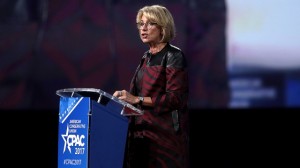Betsy DeVos’s problem with numbers
Education Secretary Betsy DeVos has a problem with numbers. As in, she sometimes cites numbers that just aren’t accurate. DeVos, of course, is hardly the only government official to cite inaccurate numbers to make a point, but that’s no reason not to point it out when she does — and she did during two appearances in the last week before congressional committees when defending the Trump administration’s proposed 2021 budget. Let’s look at a few examples from her testimony. One misleading figure that gets repeated, and not just by DeVos, is this: There are 1 million students on waiting lists at charter schools throughout the country.
Misleading.
According to DeVos, there has been no growth on NAEP scores in the last 20 years. She said the federal government has spent “over a trillion dollars at the federal level to close the achievement gap in the last 40 years” but “that achievement gap has not closed one bit.”
According to DeVos, there has been no growth on NAEP scores in the last 20 years. She said the federal government has spent “over a trillion dollars at the federal level to close the achievement gap in the last 40 years” but “that achievement gap has not closed one bit.”
More From The Washington Post (subscription required):














